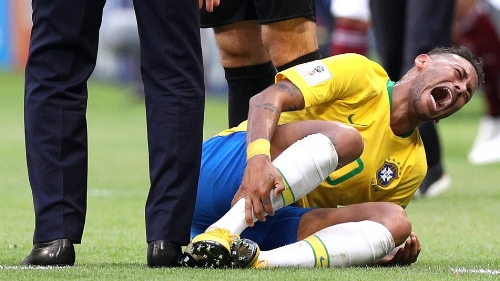Just Keep Swimming: The Diving Paradox in Football
Late in their crucial knockout game against Mexico, Neymar took a tumble out of bounds. Seated with the ball between his ankles, Mexico’s Miguel Layun – seeking to push Mexico’s run of momentum - rushed in to grab the ball and as he did so, stepped the end of his boot on Neymar’s ankle. Neymar didn’t act like he’d been shot so much as his foot had been detached at the ankle. Play was halted for several minutes. Neymar appeared anguished, looking like a man lost and begging of his Lord and saviour, “Why me?”
The Brazilian superstar pulled a similar piece of theatrics in the group stage against Costa Rica, too. 85 minutes into a scoreless game against Costa Rica, Neymar burst into the box. He made a quick juke to his left then shimmied back and as the defender fell off balance, he brushed the Brazilian’s waist. Neymar comically threw his arms out to the side, opened his mouth wide in shock, and began a slow, tragic fall backwards to the ground. While the initially penalty awarded was rescinded (VAR works? It works!), the performance did not go unnoticed by fans.
For the World Cup transients who jumped into to the sport only for the biggest tournament in the world, this seems an abomination. Neymar dives and embellishes. He is soft and, worse yet, is a cheater. Any sport that allowed plays like that to happen and players like that to thrive must be the worst sport ever.
Rest assured, diehard football fans are probably more aggrieved than you. It doesn’t make them proud. But they don’t turn away. Football fans recognize, as any fan does of their sport, how to contextualize the madness. Theatrics in football are ugly, yes, but they are also not as common as it its critics would try to convince you.
Neymar is simply playing the game.
The subtleties of going to ground are easily missed on television. It’s much easier to see when you’re down on the field or in the thick of it. How can you know just how well Tom Brady can use his eyes to look off defenders if you’ve never been baited by a quarterback yourself? How can you know just how incredible Sidney Crosby is at powering to the net if you’ve never tried to close-off a forward cutting to the net? How can you know what kind of contact in football results in a player going down?
A first lesson in contact sports: getting stepped on hurts. Especially in football. The cleats are the lightest on the market and offer next to no protection. And those studs on the bottom? Studs are sharp and pointy. They crack nails and gouge skin. Studs don’t feel good when pressed down under 180 pounds of sprinting, kicking human.
You know what makes cleats even more hazardous? The target that rolls around on the ground is conveniently level with a very, very tender area: your legs. The toes are the tiniest bones in the body and break easily. Your ankles have an exposed bone - on both sides. The knees and shins have as much protection from skin as you get from a t-shirt. And have you seen the shinpads these days? They offer as much coverage as a pillow does a model in a Maxim centerfold.
Combining those elements with a game that integrates more sudden changes in direction and speeds than any sport is a recipe for some stingers. All it takes is one poorly timed challenge by a defender and their cleats are sniping at your Achilles, like running a forest trail clogged with branches.
Ok, fine, but what about all the rolling around on the ground, you say?
In other sports played on grass that make contact an objective, like rugby or American football, the style of running prioritizes preparing for contact, squaring up your shoulder and dropping your center of gravity. All you have to focus on is contact. Footie is about getting passed your man, absent the expectation of a collision with a ball at your feet to worry about.
So do yourself a favor; go for a sprint then ask your buddy to hip check you right in stride. I doubt you stay up. In football, you almost never have two feet squarely on the ground while in motion. Few players have the kind of balance and center of gravity (or play so close to the ground) as Lionel Messi.
Neymar’s theatrics as not typical to the sport. He is as practiced at it as his free kicks. But Neymar also has very good reasons: few players are fouled as often. Neymar’s game breaking ability goes part in parcel with the fouls he receives. Few players enjoy having a rainbow flick on them, so they lash out in frustration (hockey players should be able to relate) and foul him. Neymar’s ability to beat defenders off the dribble leads many to clutch, grab, or generally impede his progress. These are fouls. That he embellishes guarantees the call, right or wrong.
As we saw on Monday, though, this style is playing with fire. Embellish to get the call and eventually you lose the benefit of the doubt. Every time you go to ground, whether your ankle was snipped or a player pulled you off balance, you’re a diver. What was legitimate becomes illegitimate.
Football always has a handful of players trying to find the line and cross it. To place the blame over the antics of the most egregious violators on the whole sport is just a bit unfair. As unfair as Neymar throwing himself to the ground, looking for attention.

